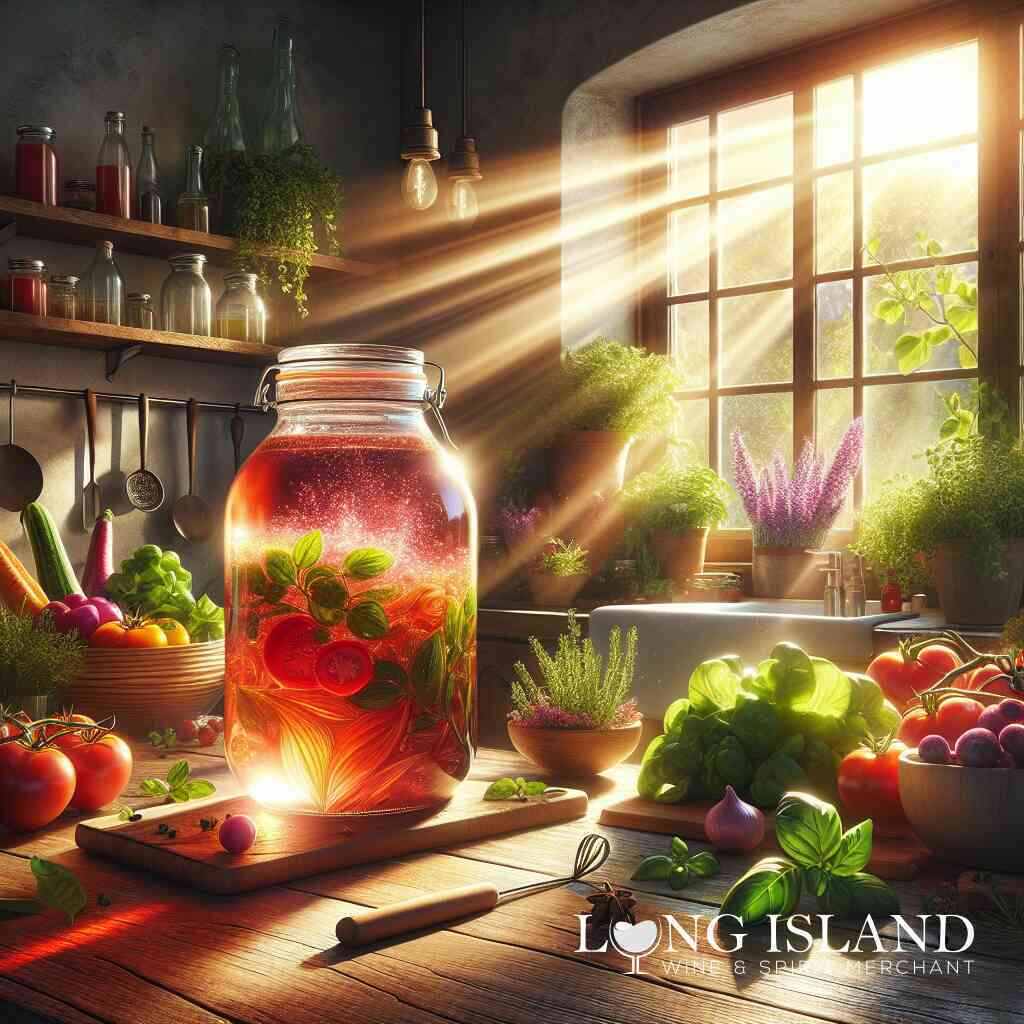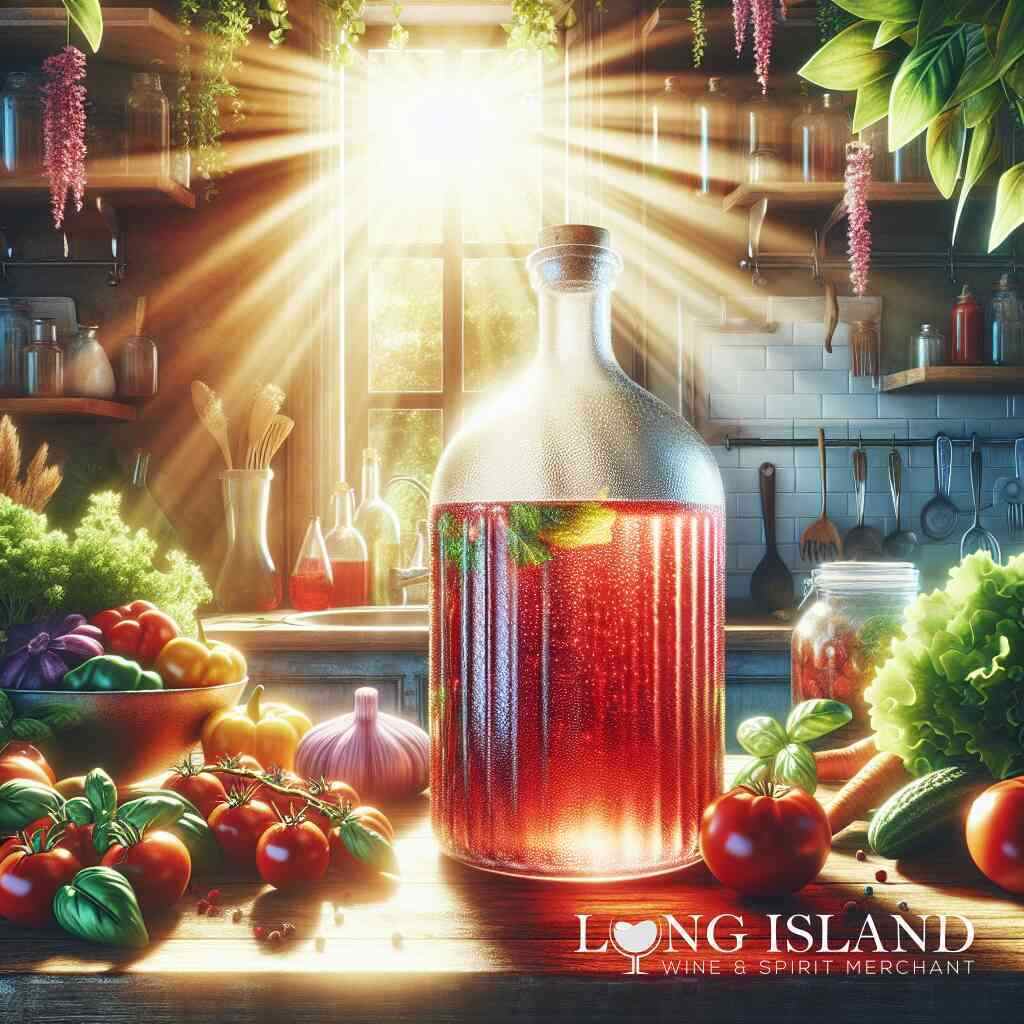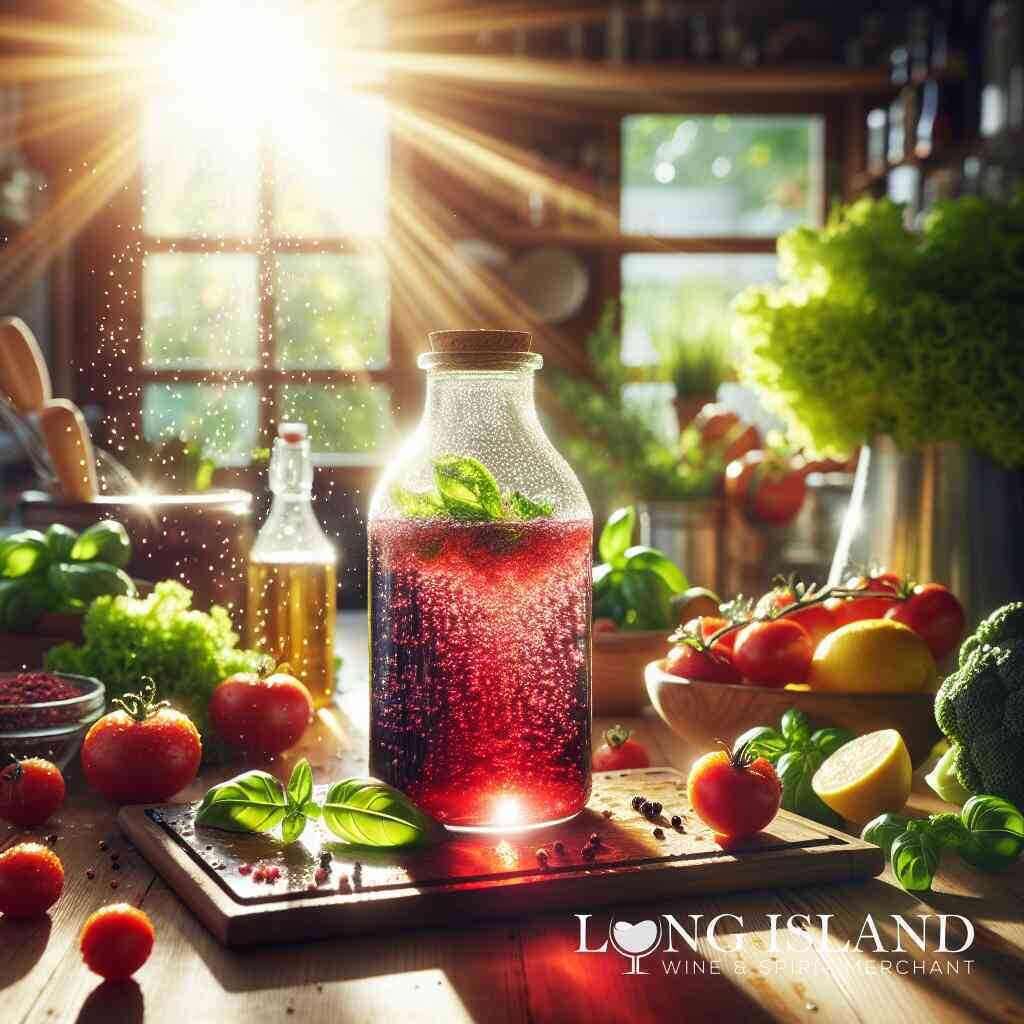
How to Make Red Wine Vinegar?
August 13, 2024
Introduction to Homemade Vinegar Making
The art of transforming red wine into vinegar
Transforming red wine into vinegar is an age-old process that marries the simplicity of natural fermentation with the complex flavors of fine wines. This alchemical transformation takes place through the action of acetic acid bacteria, which convert alcohol into acetic acid, giving vinegar its distinct sharp taste and aroma. From Long Island wines for vinegar making, selecting the suitable base wine is paramount. A bottle that might have gone slightly off or a leftover red that’s lost its prime drinking quality can find new life as a flavorful vinegar, adding depth and character to culinary creations.
Understanding the basics of vinegar fermentation
Vinegar fermentation hinges on both science and art. At its heart, this process relies on the acetic acid bacteria that thrive in alcoholic environments. These bacteria, floating freely in the air or introduced through a “mother” of vinegar, feast on alcohol and oxygen, producing acetic acid as a byproduct. The journey from wine to vinegar isn’t instantaneous- it requires patience, precise conditions, and a bit of intuition about when the vinegar has reached its peak flavor profile. Fermentation is an unpredictable ally, often yielding subtle differences in each batch of homemade vinegar, making each one a unique culinary treasure.
Why homemade red wine vinegar is a sustainable kitchen project
Embracing DIY vinegar projects aligns with sustainable living practices by upcycling leftover or undesired wine into a product of value. Instead of discarding half-consumed bottles of wine, transforming them into vinegar reduces waste and provides a homemade ingredient that enhances the flavor of food. This practice not only adds a layer of personalization to your cooking but also resonates with a history of kitchen frugality and creativity. Additionally, homemade red wine vinegar, free from industrial processing, can contribute to a healthier diet, adding a dimension of satisfaction to sustainable living using wine upcycling in home kitchens.
Selecting the Perfect Base Wine
Choosing the right red wine for vinegar-making
When embarking on the journey of creating homemade red wine vinegar, the first and perhaps most crucial step involves selecting the ideal base wine. Not all wines are created equal when it comes to vinegar production; the choice of red wine can significantly influence the taste, aroma, and quality of the final product. A robust red wine with a balanced flavor profile is preferred, as it will impart a rich and nuanced complexity to the vinegar. Avoiding wines that are overly sweet or have been artificially flavored is essential, as these characteristics can lead to unbalanced vinegar. For those living near Long Island, selecting wine for homemade vinegar near Long Island can be an exciting adventure, providing a plethora of high-quality options that cater to diverse palates and vinegar-making endeavors.
The role of alcohol content in wine vinegar production
The alcohol content of the wine chosen for vinegar-making plays a pivotal role in the fermentation process and the quality of the resulting vinegar. Generally, wines with an alcohol content ranging from 6% to 14% are ideal for vinegar production. Wines with alcohol levels within this range provide a conducive environment for the acetic acid bacteria to thrive and transform the alcohol into acetic acid efficiently. It’s a delicate balance; too little alcohol might slow down the fermentation process or lead to weak vinegar, while too much can inhibit the bacteria’s activity, halting fermentation altogether. Understanding the importance of alcohol content aids in honing the fermentation process, ensuring a successful transformation of wine into a beautifully crafted vinegar.
Our wine rack essentials from Long Island Wine and Spirit Merchant
The selection process for the perfect base wine is made more accessible with the extensive collection from Long Island Wine & Spirit Merchant. Our wine room, Long Island, for vinegar wine selection, offers an array of red wines that are impeccable for vinegar making. Whether you’re looking for a full-bodied Cabernet Sauvignon, a delicate Pinot Noir, or a robust Merlot, our collection caters to every vinegar artisan’s needs. Each bottle from our wine rack holds the promise of transforming into vinegar that enlivens your culinary creations. Our knowledgeable staff can guide you through our wine selection, helping you find the red wine that not only suits your taste but also has the ideal characteristics for vinegar making. Choosing from our curated collection ensures that your DIY vinegar project in Long Island starts with the highest quality base, imbuing your vinegar with unparalleled depth and character.
Preparation for Vinegar Fermentation
Gathering necessary equipment for DIY vinegar
Before you embark on your journey of transforming red wine into a delectable homemade vinegar, gathering the right equipment is a pivotal first step. For any DIY vinegar projects in Long Island, starting with the basics is crucial: a clean, wide-mouthed glass jar or a wooden barrel is essential, depending on the volume of vinegar you wish to produce. You’ll also need cheesecloth or a breathable cloth to cover the opening, securing it with a rubber band or string to allow airflow while keeping out dust and insects. A thermometer and a pH meter will also be handy in monitoring the fermentation process, ensuring the conditions are just right for the acetic acid bacteria to thrive.
How to create or obtain your vinegar mother
The foundation of any vinegar is the “mother,” a gelatinous colony of acetic acid bacteria and cellulose. Creating your mother from scratch involves patience and a bit of luck, as it requires capturing wild bacteria present in the air. For those who prefer a sure start, sourcing wine vinegar mothers in Long Island is made easy through reputable suppliers who offer vinegar mothers specifically cultivated for making high-quality vinegar at home. You can also initiate a mother by adding a small amount of unpasteurized, raw vinegar to the wine intended for fermentation. This method ensures a more prosperous and more predictable fermentation process, leading to superior-quality homemade vinegar.
Sanitization and set up for successful fermentation
Sanitization is paramount in vinegar making, as the presence of unwanted bacteria or yeasts can hinder the fermentation process or result in spoiled vinegar. All equipment should be thoroughly cleaned and, if possible, sterilized before use. A solution of water and vinegar or a food-safe sanitizer can be used to clean the containers and any tools involved in the process. Once sanitized, the initial setup is straightforward. Combine your base wine with the vinegar mother in the prepared container, leaving enough air space to facilitate proper oxygenation. Cover it with breathable cloth, securing it to prevent any contaminants from entering. Position your setup in a dark, room-temperature area where it can remain undisturbed yet easily accessible for monitoring its progress. This careful preparation paves the way for successful fermentation, turning a simple bottle of wine into artisanal vinegar with a depth of flavor unattainable in commercial varieties.

The Fermentation Process Explained
Step-by-step guide to acidifying red wine
Transforming your chosen red wine into an artisanal vinegar involves a fascinating process of acidification, a journey from alcohol to tangy acetic acid that adds a zesty depth to countless dishes. Beginning with the right, perhaps a robust blend selected from the Long Island Wine & Spirit Merchant’s curated wine rack is crucial for achieving a vinegar that sings with complexity and balance.
First, ensure your wine and equipment have been prepped as outlined; your wine should be at the ideal alcohol content, and your jar or barrel should be sterilized. Next, introduce the “mother” of vinegar to the wine. This symbiotic culture of bacteria and yeast kicks off the conversion process. For those undertaking DIY vinegar projects in Long Island, incorporating a bit of existing raw, unfiltered vinegar can accelerate this step, introducing a healthy dose of acetic acid bacteria to the mix.
Then, cover the container with a breathable cloth and secure it. This setup allows oxygen to interact with the fermenting wine, a vital element for the bacteria during their work. Place your container in a dark, warm (but not too hot) spot where it can stay undisturbed but monitored. The ideal temperature for fermentation hovers between 60°F and 80°F (15°C and 27°C), a range that supports vigorous bacterial activity without risking the evaporation or spoilage of the base wine.
Monitoring the fermentation: smell, taste, and visual cues
As days turn into weeks, your red wine will begin transforming into vinegar, a process that can be monitored through smell, taste, and sight. Initially, you might notice fruity aromas evolving into sharper, more acetic scents-this is a good sign. As the fermentation progresses, a layer of the mother may form on the surface, indicating active bacterial work. Don’t be alarmed; this is a positive indicator of vinegar development.
Tasting your vinegar-in-progress is crucial; gently remove a small sample every few weeks to evaluate its acidity and flavor. Look for a balanced sharpness, an indicator that the vinegar is nearing completion. Visually, clarity and a decrease in the mother’s growth can also signal readiness. It’s a delicate balance short, and the vinegar will be weak; too long, and it could become too harsh.
For guidance and supplies for your fermented endeavors, Long Island Wine & Spirit Merchant offers expertise and products catering to diy vinegar projects in Long Island, ensuring your vinegar meets your artisanal aspirations.
The role of acetic acid bacteria in souring wine
The magical transformation of wine into vinegar is primarily thanks to acetic acid bacteria, a group of aerobic bacteria that thrive in alcoholic environments. Understanding the role of acetic acid bacteria in souring wine is fundamental to mastering vinegar making. These bacteria consume ethanol, the alcohol in wine, and oxygen from the air, converting them into acid- the sour, pungent compound giving vinegar its distinctive profile.
Various factors, including temperature, alcohol content, and oxygen availability, influence this bacterial activity. Ensuring these conditions are optimal means the difference between a flat, lifeless concoction and a vibrant, tangy vinegar that enhances any dish it touches. Successful vinegar-making marries science with the sensory pleasures of cooking, transforming simple ingredients into something more significant than the sum of their parts. With patience and attention to detail, any wine enthusiast can explore the joys of making red wine vinegar, turning a good meal into an unforgettable experience.
Aging, Filtering, and Storage of Your Homemade Vinegar
How long to age your red wine vinegar for optimal flavor
The aging process of red wine vinegar is where the magic happens, turning a simple fermented wine into a depth-rich vinegar with layers of flavor. Ideally, aging your vinegar for a minimum of two months up to six months, depending on the desired intensity and complexity of flavor, is recommended. During this time, the acetic acid continues to develop, and the vinegar’s character deepens, influenced by the nuances of the original wine used. For those who have embarked on artisan vinegar creation with Long Island spirits, patience during the aging phase allows the bold flavors imbued by Long Island’s terroir to mature, resulting in a genuinely unique vinegar.
The storage environment plays a crucial role in this phase. Vinegar should be stored in wooden barrels or glass bottles in a cool, dark place to prevent any degradation of quality. The type of container can impart subtle flavor notes to the vinegar-oak barrels, for example, can add a hint of woodiness that enhances the complexity of the final product.
Techniques for filtering and clarifying your vinegar
After aging, your vinegar might appear cloudy with remnants of the vinegar mother suspended in the liquid. While this cloudiness is average and not a sign of spoilage, achieving clear vinegar is often desired for aesthetic reasons and to ensure a smoother taste. Filtering can be accomplished using a coffee filter or fine mesh cloth placed over a funnel or a filter. Slowly pour the vinegar through the filter into a sterilized container. This process might need to be repeated several times to remove all particulates.
Furthermore, clarification not only improves the appearance but can also refine the flavor profile of your vinegar. This involves allowing the vinegar to sit undisturbed, letting gravity pull any remaining solids to the bottom of the container, after which the clear vinegar can be gently decanted, leaving the sediment behind. This gentle handling preserves the integrity of the vinegar’s flavor while presenting it in its most appealing form.
Best practices for storing and preserving homemade vinegar
Proper storage is essential for maintaining the quality and extending the shelf life of your homemade red wine vinegar. Once filtered and clarified, bottling your vinegar in clean, airtight containers will protect it from oxidation and contamination. Glass bottles with screw-top lids or corks are ideal as they don’t react with the vinegar, ensuring the flavor remains unaltered.
Keeping vinegar in a cool, dark place helps preserve its color and flavor intensity. Exposure to direct sunlight or high temperatures can degrade the quality of the vinegar over time. For those invested in sustainable living using wine upcycling in home kitchens, understanding these storage principles is critical to maximizing the lifespan of your vinegar, allowing you to enjoy the fruits of your labor for many months or even years.
Furthermore, homemade vinegar, when properly stored, does not have a definite expiration date and can continue to age gracefully, developing more nuanced flavors over time. However, if any signs of spoilage, such as mold growth or off odors, are observed, it’s essential to discard the vinegar to avoid health risks. Regularly checking on your stored vinegar and using clean utensils for handling can prevent contamination and ensure your vinegar remains a healthy and flavorful addition to your culinary repertoire.
Creative Uses and Health Benefits of Red Wine Vinegar
Incorporating homemade vinegar into healthy condiments and salad dressings
Crafting your red wine vinegar at home, with the superior selection from Long Island Wine & Spirit Merchant, opens the door to a realm of culinary creativity. Homemade vinegar provides a foundation for healthy condiments and salad dressings that are free from the preservatives and artificial additives found in store-bought varieties. Imagine drizzling a vinaigrette over your fresh garden salad, bursting with the nuanced flavors of a fine red wine-turned-vinegar. This transformation not only elevates your food but allows you to control the ingredients, ensuring they align with your dietary preferences and health goals. Salad dressings made from homemade red wine vinegar, a touch of extra virgin olive oil, fresh herbs, and a hint of garlic can turn an ordinary meal into a gourmet experience, all the while contributing to a balanced and healthy diet.
The health benefits of adding artisan vinegar to your diet
Integrating artisan vinegar, especially one that’s been crafted from the quality wines of Long Island, into your daily diet carries a suite of potential health benefits. Vinegar has been touted for its ability to aid in digestion, regulate blood sugar levels, and even contribute to weight management. The benefits of homemade vinegar for health are amplified by the absence of synthetic chemicals, offering a pure and potent product. Consuming foods with vinegar can help in maintaining a healthy gut microbiota, which is crucial for overall well-being. Its acidic nature encourages a balanced pH in the digestive system, which may aid in the absorption of essential minerals from our diets. By choosing to make your vinegar, you’re not just adding flavor to your meals; you’re investing in your health with every drop.
Upcycling wine: from our wine selection to your vinegar pantry
The journey from a carefully curated wine to a bottle of exquisite homemade vinegar encapsulates the spirit of sustainable living. Long Island Wine & Spirit Merchant provides an extensive selection of red wines that serve as the perfect foundation for your vinegar-making venture. Upcycling wine into vinegar not only gives purpose to leftover or unused bottles but also reduces food waste. By selecting Long Island wine cases for vinegar making, you can embark on this eco-friendly project, transforming a sumptuous red wine into a pantry staple. This process not only enriches your culinary creations but also brings a sense of accomplishment and connection to the artisan crafts of earlier generations. From our wine rack to your vinegar pantry, each step in this process is a testament to the possibilities of homemade excellence and the virtues of a circular economy.

Conclusion: Embracing the Artisan Spirit
The rewards of making your red wine vinegar
The journey of transforming red wine into artisan vinegar embodies a craft that rewards patience, creativity, and a deep appreciation for the nuances of taste and tradition. Making your red wine vinegar is not merely an exercise in culinary skill but a statement of personal craftsmanship and a nod to the rich history of fermentation. The rewards of this endeavor extend beyond the kitchen, offering a sense of accomplishment and a tangible connection to the food we consume. As you uncork a bottle of fine red wine from Long Island Liquor Store for vinegar base wine, consider the future life of this wine as a vinegar. It’s a journey from grape to glass to gourmet ingredients, each bottle telling its own story of transformation and taste.
Sustainable living through kitchen DIY projects
Kitchen DIY projects, like making red wine vinegar, are more than hobbies-they are practical steps toward sustainable living. By upcycling wine that might otherwise be wasted, you take an active role in reducing food waste and crafting products that are free from unnecessary additives and packaging. This approach to sustainable living through vinegar-making reflects a broader commitment to environmental stewardship and mindful consumption. It’s a way to blend the joys of culinary exploration with the principles of sustainability, creating products that are not only better for our plates but also for our planet.
How to continue exploring vinegar-making and other culinary projects
Your adventure in making red wine vinegar is just the beginning of what can be a lifelong exploration of fermentation and culinary projects. Expanding your repertoire to include different types of vinegar, such as white wine, balsamic, or apple cider vinegar, can add diverse flavors to your cooking and open up new avenues for experimentation. Engaging with local wine and spirits suppliers, like Long Island Wine & Spirit Merchant, can provide you with a wealth of resources and inspiration, enriching your journey into the world of vinegar making and beyond. Seeking out workshops, digital marketing partners for vinegar-making websites, and online communities can further enhance your skills, providing a platform for sharing knowledge and celebrating the artisan spirit that drives your culinary adventures. Whether it’s mastering the art of vinegar making, exploring fermentation in other forms, or delving into home brewing, the possibilities are as boundless as your curiosity and creativity.
Frequently Asked Questions
Question: Can Long Island Wine & Spirit Merchant recommend the best type of red wine for making homemade red wine vinegar?
Answer: Absolutely! At Long Island Wine & Spirit Merchant, we pride ourselves on our extensive selection of fine red wines that are ideal for your vinegar fermentation projects. When choosing a red wine to transform into homemade red wine vinegar, we often recommend a balanced, full-bodied red wine, such as Cabernet Sauvignon, Merlot, or Pinot Noir from our curated wine rack. These selections provide the robust foundation necessary for crafting artisan vinegar with rich, nuanced flavors. Our knowledgeable staff is always available to help guide you through our wine selection, ensuring you embark on your DIY vinegar journey with the best base wine, aligning perfectly with sustainable living and kitchen DIY projects.
Question: What supplies do I need to start making vinegar at home, and can I find them at Long Island Wine & Spirit Merchant?
Answer: To start your adventure in making vinegar at home, you’ll need a few essential supplies: a clean, wide-mouthed glass jar or wooden barrel, cheesecloth or a breathable cloth for covering, and a rubber band or string to secure it. While the primary focus at Long Island Wine & Spirit Merchant is on providing you with the highest quality wines for your vinegar production and other culinary projects, we can offer valuable advice on where to find these supplies locally in Commack, New York, or we may direct you to our trusted partners. Additionally, our team is keen to assist with any queries you have about the vinegar fermentation process, ensuring you have all the information needed to kickstart your kitchen DIY projects.
Question: In your blog, ‘How to Make Red Wine Vinegar? ‘, you mention a ‘vinegar mother.’ Can I purchase a vinegar mother directly from Long Island Wine & Spirit Merchant?
Answer: While Long Island Wine & Spirit Merchant primarily specializes in offering a wide variety of fine wines and good spirits, including red wine that you can transform into DIY vinegar, we don’t directly sell vinegar to mothers. However, we are deeply invested in supporting your culinary projects and sustainable living efforts. Our staff can guide you to reputable suppliers to obtain a high-quality vinegar mother. Additionally, we’re here to provide assistance and knowledge on creating your vinegar mother using raw, unpasteurized vinegar, meshing seamlessly with our curated selection of red wines suitable for initiating the natural fermentation process.
Question: How long does the process of acidifying red wine into artisan vinegar usually take?
Answer: The fascinating journey of transforming red wine into artisan vinegar through the natural fermentation process typically spans several weeks to months. This timeframe can vary greatly depending on factors such as the initial alcohol content of your wine, the ambient temperature, and the specific strains of acetic acid bacteria present. Generally, a period of 2 to 6 months is recommended for allowing your red wine vinegar to age, developing the optimal flavor profile. At Long Island Wine & Spirit Merchant, we emphasize patience and dedication to this craft, as the extended aging period allows the intricate flavors inherited from our Long Island wine selection to mature, culminating in homemade red wine vinegar of exceptional quality and depth.
Question: Are there any tips for storing homemade vinegar to ensure its longevity?
Answer: Proper storage is crucial for preserving the quality and extending the life of your homemade vinegar. Once your vinegar has completed fermentation, achieved the desired acidity, and has been filtered and clarified, it should be stored in clean, airtight glass bottles. These storage vessels should then be kept in a cool, dark place away from direct sunlight. This method helps maintain the vinegar’s color and flavor integrity. Long Island Wine & Spirit Merchant recommends adopting these storage tips as part of your food preservation practices, ensuring that your artisan vinegar, crafted from our selection of fine red wine, remains a delightful addition to your pantry for healthy condiments, salads, and culinary creations long after its creation.



